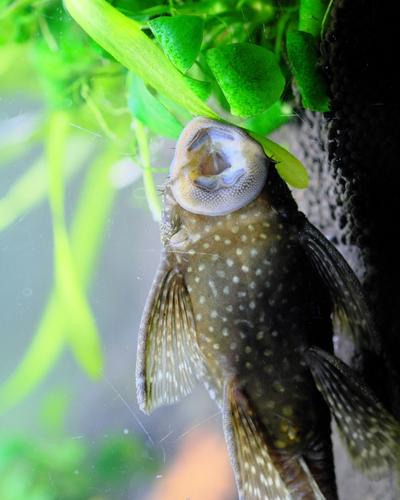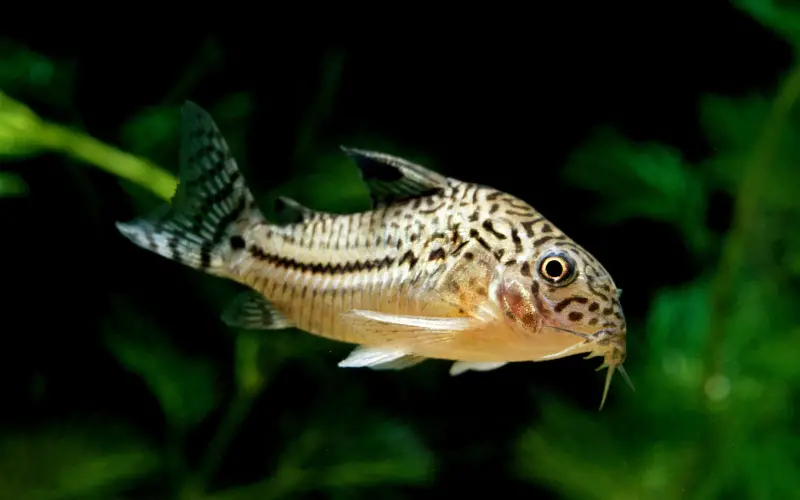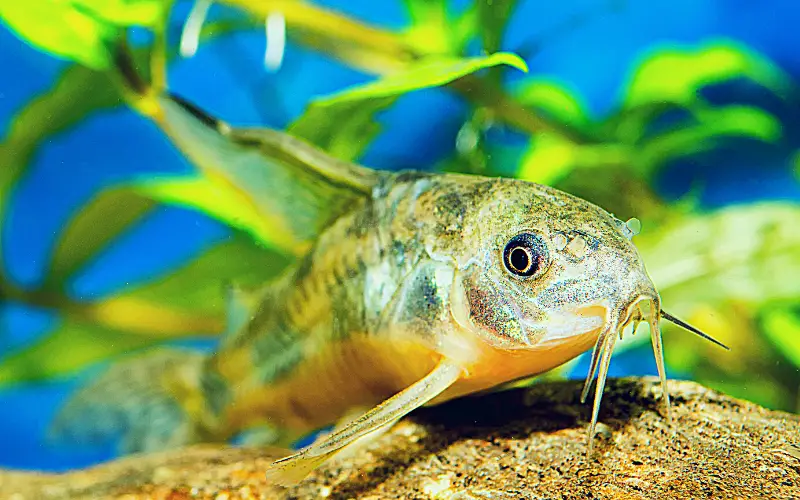For any aquarist, one of the most important parts of keeping Corydoras fish is ensuring they are as comfortable as possible in their home. So, How to Tell If a Cory Catfish Is Stressed?
This is especially true for Cory cats or Corydoras Catfish – these bottom dwellers can be incredibly sensitive to environmental changes or behaviors that may indicate stress.
From physical signs a fish is stressed such as a poor appetite or inability to move correctly to more subtle cues like sluggish Corydoras behavior and general agitation, it’s important to know what warning signs indicate your elegans Cory catfish is anxious.

Read on for five clear indications that things are not going well with your critter!
Table of Contents
ToggleAre My Cory Catfish Happy?
Yes, Cory fish can be happy in the right environment. make sure their tank is properly sized (larger than 10 gallons) and provide plenty of hiding places with rocks, logs, planted aquarium parts, or other decorations. To ensure they are healthy and content,

Also, keep the water temperature between 72°-78°F and maintain a neutral pH balance between 6.5 – 7.0 for optimal health and happiness. Lastly, don’t feed or overfeed – 1/4 to 1/2 teaspoon of food per individual fish once a day should suffice!
How to Tell If a Cory Catfish Is Stressed?
How do you know if a Cory catfish are stressed? When determining if a Corydoras Catfish is stressed, the most telltale signs are lethargy, refusal to eat, and spending a lot of time sitting in one spot.
Other signs may include swimming upside down more frequently at the top of the tank’s surface and its fins having a reddish hue.
If you’ve noticed any of these behaviors in your Cory fish, it’s likely that it is stressed out and should be monitored closely for any further changes in behavior or health.
The Effects of Stress on How Cory Catfish Swims
When a Cory Catfish is stressed, it can profoundly impact its swimming sideways patterns and behavior. Stressed fish will show signs of odd swimming patterns, erratic swimming, or unusual Corydoras behavior, such as spending long periods at the surface of the Cory catfish tank.
In addition to this, they may also swim in an S-shaped pattern, rub up against objects, or swim around objects they normally wouldn’t.
An increase in cortisol (a hormone caused by stress) can also decrease swimming behavior.
5 Clear Warning Signs Your Cory Catfish Is Stressed
What are the signs of stress in Corydoras? and why is my Cory catfish swimming crazy? While many catfish warning signs can indicate a fish is feeling stressed, some key ones to look out for include:
Cory Catfish Not Eating & Loss of Appetite
A decreased appetite or refusal to eat can indicate that your wild-caught Cory catfish is stressed.
Cory Catfish Gills Moving Fast
Fast gill movements indicate that your Cory fish has difficulty breathing, which can signify stress.
Sluggish behavior
If your Cory Catfish appears sluggish or lethargic, this could be a sign of stress.
Fish Spending more time at the top of the tank
Why are my Cory catfish swimming up and down? Fish Staying Too Long on Top: Your Corydoras Catfish may be spending more time swimming at the top of the tank if it is feeling stressed, as this more Corydoras swimming up and down glass could indicate it is trying to survive and take advantage of increased oxygen levels.
Indefinite Shapes and Patterns
If you notice your cory catfish swimming erratically in indefinite shapes or patterns, they may be attempting to swim to escape their environment. This could indicate that they are feeling stressed and uncomfortable.
In short, any aquarist must know the signs of a stressed pleco Catfish to ensure their pet remains safe, healthy, and happy.
Paying attention to their own species’ behavior and environment can help prevent potential issues before they become a problem.
When in doubt, consulting with an experienced aquarist or veterinarian is recommended to ensure your Cory Catfish is healthy and content!
Major Reasons Cory Catfish Are Stressed
Corydoras Catfish can become stressed for various reasons, including water and feed quality issues, overcrowding, and incompatible mates. Some of the most common reasons for stress in Cory Catfish include:
Water Temperature Fluctuations
Any sudden changes in the tank’s water temperature can cause Cory Catfish to become stressed.
Incompatible Tank Mates
Having incompatible tankmates, such as aggressive or territorial fish, can cause stress to your Cory Catfish. It is best to research Cory’s catfish tank and choose suitable tankmates before adding them to the tank.
Stressed Due to Poor Water Conditions
Having poor water quality can be a major source of stress for your Cory Catfish, as it reduces the amount of oxygen available in the tank. It is important to regularly check your water parameters and make sure they are within the correct range for your fish.
Overcrowded Tank
An overcrowded community tank can cause immense stress to your Cory Catfish, as it reduces the amount of empty air and space they have to swim and explore. To avoid overcrowding and keep your fish happy and healthy, ensure you provide enough space for all your tank inhabitants.
Very Strong Water Flow
Strong water flow can be very stressful for fish species such as Cory Catfish, as the water changes can make it difficult for them to move around, swim, or find food.
Inadequate Substrate
Cory Catfish need a soft substrate to rest and search for food, so that an inadequate substrate can be very stressful for schooling fish. It is best to use a substrate that is soft and does not have sharp edges.
Cory Catfish Diseases
Finally, any diseases or parasites your Cory Catfish may suffer can cause stress. It is important to monitor your fish for signs of disease and treat them with appropriate medical care if necessary.
By understanding the causes of stress in Cory Catfish, you can better prepare your tank environment and provide them with the best possible care!
It is also important to know how to reduce stress in Cory Catfish so that they can remain healthy and happy. So, How Do I Make My Cory Catfish Happy?
Some Ways to Reduce Stress in Cory Catfish include:
Provide a suitable tank environment:
Ensure your tank has the correct substrate, water temperature, and pH levels to ensure your Cory Catfish feel comfortable.
Choose compatible tank mates:
Do your research to find compatible tank mates for your Cory Catfish. Avoid having aggressive or territorial fish in the same tank as your Cory catfish swimming frantically with other fish, which can cause stress.
Monitor water parameters:
Regularly check the tank’s water parameters to ensure they are within the correct range for your fish species.
Provide adequate hiding places:
Cory Catfish need plenty of hiding places in their environment, so make sure your tank has plenty of plants, rocks, and other objects to hide in.
Following these steps can help reduce stress in your Cory Catfish, resulting in a happier and healthier fish!
Maintaining your Cory Catfish’s health is important for their overall well-being. Paying attention to their behavior and environment can help prevent potential issues before they become a problem.
Understanding how to help Cory catfish relax is a challenging endeavor. Scientists are experimenting with temperature and nitrate levels alterations, paving the way toward relieving stress for these beloved creatures.
When in doubt, consult with a knowledgeable fish-keeper or veterinarian is recommended to ensure your Cory Catfish is healthy and content!
What Is Normal Cory Catfish Behavior?
Why is my Cory catfish swimming crazy? Cory Catfish are generally peaceful fish that enjoy exploring and scavenging around the tank. They can also be quite social, and some species even form small schools of fish.
Normal wild Cory Catfish behavior includes swimming around the tank, searching the substrate for food, and interacting with their tankmates. They may also display territorial behavior towards other Cory Catfish, which is usually not aggressive.
In general, if your Cory Catfish display normal behavior and seem content in their environment, they are likely healthy and happy!
How to Tell If Corydoras Are Happy?
How to know if your Cory catfish is happy? There are a few telltale signs that you can look for to determine if your Cory Catfish is happy.
Happy Cory Catfish usually display dynamic behavior, such as swimming around the tank and searching for food.
They will also be more social with their tank friends and mates, and you may see them forming small schools of other fish together. A healthy Cory Catfish will also show signs of good coloration and appetite.

Suppose you notice changes in your Cory Catfish’s behavior, such as decreased activity levels or aggression towards the new tank or mates. In that case, it is important to investigate what may be causing the stress.
Overall, Cory Catfish are enjoyable and hardy fish that make a great addition to any fish tank. By understanding the causes and signs of a stressed fish, you can ensure your Cory Catfish are happy and healthy!
Why Is My Cory Catfish Shaking?
Why is my Cory catfish swimming crazy? If your Cory Catfish is shaking or twitching, it could be a sign that they are experiencing stress. This can happen due to poor water conditions, incompatible or aggressive tankmates or mates, or even being startled by sudden movements.
It is important to investigate what may be causing the stress and take steps to fix the issue. Ensure your tank is properly maintained, with the correct water parameters and compatible tank mates.
If the shaking persists, it is best to consult a knowledgeable fish keeper or veterinarian.
Will Cory Catfish Pass Away Because of Stress?
Cory catfish may pass away due to stress. Stress can be caused by many things, including stocking too many fish in the same tank, improper feeding, or changing temperature and water chemistry.
These issues cause stress in the fish leading to weakened immune systems and making them vulnerable to infections or other illnesses. If stress levels exceed the capacity of the fish, serious illness or even death could occur.
Keeping your aquarium environment stable with appropriate stocking levels and regular water parameters testing and maintenance is important. To prevent this from happening,
What Causes Cory Catfish to Die?
Cory catfish death spiral can occur due to a variety of issues. Poor water quality, including high levels of ammonia or nitrite, can result in fish death.
Inadequate oxygen levels, drastic water temperature changes, or overcrowding can also lead to fish death.
Stress can also be a factor, as it weakens the immune system leaving fish vulnerable to illnesses and infections.
If any of these issues are present, rectifying the situation as soon as possible is important to prevent further large fish losses.
Why Is My Cory Catfish Suddenly Dying?
Cory catfish dying suddenly can be a sign of an underlying issue. Investigating what may have caused the sudden death is important to prevent future losses.
Common causes of sudden death include water quality issues such as high levels of ammonia or nitrite, oxygen deprivation, drastic changes in temperature, incompatible neighbors, or overcrowding.
It is also important to note that sudden death can be caused by stress, so it is important to investigate any potential causes of stress in the tank and take steps to correct them.
How Do I Know If My Corydora Is Dying?
How to tell if fish are stressed of dying? If your Corydora is displaying any of the following signs, it could be a sign that they are dying:
- Lethargy – If your Corydora is not swimming with its usual energy and appears to be sleeping/resting more than normal.
- Loss of appetite – Eating less or not at all can indicate an unhealthy fish.
- Clamped fins – When a fish’s fins become clamped together and stay like this, it usually indicates stress or illness.
- Difficulty Breathing – Watch out for strange gulping motions at the water surface, which may suggest difficulty breathing.
- White Spots On Skin & Fins – A sure sign that your Corydora has some parasites on them.
If you believe your Corydora is dying, consider consulting a vet experienced in treating aquatic animals as soon as possible to give them the best chance for survival!
Do Cory Catfish Die After Laying Eggs?
No, Cory catfish do not die after laying eggs. They are quite hardy and can be very productive when spawning.
It is important to provide them with an appropriate environment for breeding, including a suitable substrate like fine gravel or sand and the correct water parameters.
It is also important to ensure that you have appropriate and aggressive tank mates, as aggressive fish can stress Cory catfish swimming them out or even attacking Cory catfish while they are breeding.
With the right conditions, Cory catfish can be prolific breeders and will not die after laying eggs.
FAQs ABOUT why do my Cory catfish swim to the top?
Why are my Cory catfish swimming at the top?
Why is my cory catfish swimming at the top of the tank? Corydoras normally breathe air at the surface. But constant top swimming suggests low oxygen levels in the tank. Check your water quality and increase surface agitation if needed.
why is my Cory catfish not moving?
Cory catfish may not be moving due to poor water quality, stress, illness, or simply resting. Observe if others are active, check water parameters, and look for signs of illness.
Why does my Cory catfish swim to the surface?
Corydoras catfish may swim to the surface for several reasons: lack of oxygen in the water, hunger, or seeking a specific food source. Check water parameters and adjust accordingly.
Why do corys swimming up and down?
why is my Cory catfish swimming up and down? Corydoras catfish swimming up and down could be a sign of oxygen deficiency in the water. Check your water parameters and ensure proper aeration.
How often do Cory catfish come up for air?
Corydoras catfish can surface for air anywhere from once an hour to several times. This behavior is normal, but very frequent surfacing might indicate low oxygen levels in the tank.
Why is my Corydoras swimming erratically?
Erratic swimming in Corydoras can indicate a health problem, such as parasites, bacterial infections, or poor water quality. Observe their behavior and test your water parameters.
Why is my Cory catfish swimming at top of tank?
Why do Corydoras swim to the surface? cory catfish swimming to top of tank to gulp air, but if it’s frequent, it could indicate low oxygen levels in the tank.
Why Cory catfish darting to surface?
Why are my Corydoras swimming at the top? Corydoras darting to the surface is normal! They gulp air occasionally. However, constant gasping might indicate low oxygen or water quality issues.
Why is my albino Cory catfish swimming crazy?
There are a few reasons your albino Cory might be darting around. It could be stressed from recent changes, excited by tankmates, or even playing! If other signs of illness are absent, it’s likely not a major issue.
Conclusion
So, how to tell if your fish is stressed? In summary, monitoring Cory Catfish for signs of stress is important. If you can detect these signs early on, you can make changes to their environment or care quickly and stop the problem from worsening. Stress can lead to several health issues, so if you want your Cory Catfishes to stay healthy and happy, you must provide them with a suitable habitat and diet that meets their needs. It’s also wise to watch for any symptoms of stress in your fish; sudden changes in behavior, decreased appetite, and discoloration is all potential signs that they aren’t feeling comfortable within their environment.
Fortunately, many affordable products are available online and in stores that can help maintain the correct water parameters and provide the perfect environment for your Cory Catfish. With the right amount of vigilance and care, you can ensure your Elegans Cory Catfishes live a peaceful and comfortable life for many years!
You might also like
- Cory Catfish Temperature – The Ultimate Care Guide for 2023
- How to Save a Dying Corydoras Catfish? 7 Illness Signs (Solved)
- Cory catfish diseases: Treatment, Causes & Prevention Tips
- Pregnant Cory Catfish: The Exclusive Breeding Guide of 2023
- How to Tell If Corydoras Are Happy & why it matters?
- Pregnant Cory Catfish Behavior: (3 WARNING Signs of Trouble)
- Green Cory Fish: Ultimate Care Guide, Tank Mates & More!




